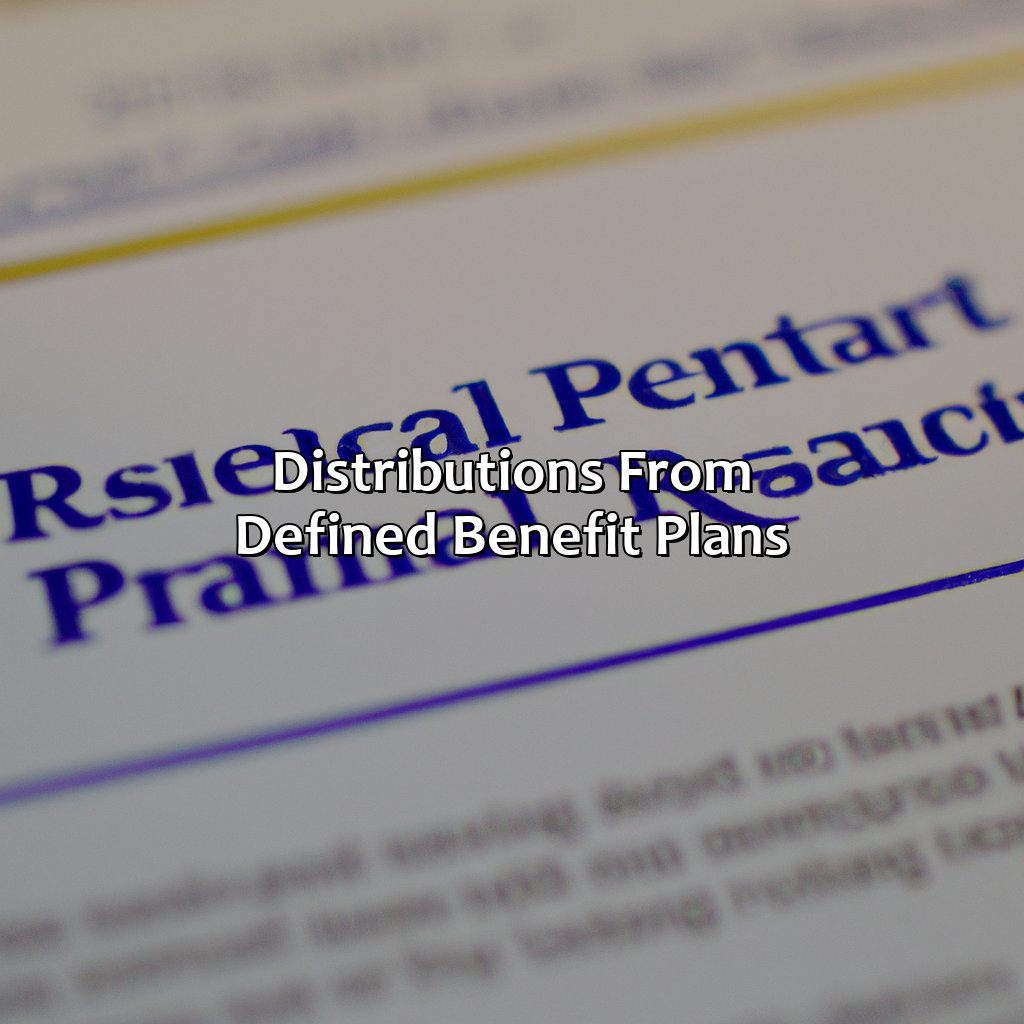What Are Distributions From A Retirement Plan?
Key Takeaway:
- Distributions from a retirement plan refer to the money that is withdrawn from the plan after retirement or a certain age limit is reached. The money can be taken as one-time lump sum withdrawals or as periodic payments.
- There are two main types of retirement plans – defined benefit plan and defined contribution plan. In defined benefit plans, the employer contributes and manages the funds, while in defined contribution plans, the employee contributes and manages the funds.
- Distributions from defined benefit plans can be taken in the form of lump sum, annuity payments, or joint and survivor annuity. While distributions from defined contribution plans can be taken in the form of required minimum distributions, lump sum withdrawals, or annuity payments.
Are you approaching the end of your working life and wondering about your retirement plan? You need to know what a distribution from a retirement plan is and how it works. Knowing this will help you make the most of your retirement plan and secure your financial future.
What Are Distributions from a Retirement Plan?
Retirement plan distributions refer to the amount of money withdrawn from a retirement account by an account owner or beneficiary. These distributions may be subject to taxes and penalties based on factors such as age, amount, and type of account. The purpose of a retirement plan is to provide income during retirement years, and distribution is the means by which this income is generated. Although distributions can be made at any time, certain rules must be followed, and any deviation may result in charges.
It is crucial to distinguish between the two primary types of distributions, which are required and non-required distributions. Required distributions must be made in accordance with IRS regulations, and failure to withdraw the required amount will result in steep financial penalties. Non-required distributions, on the other hand, are optional and can be made at any time.
Pro Tip: Before making any withdrawals, individuals should consult with a financial advisor or tax professional to determine the tax implications and any potential penalties associated with their retirement distributions.

Image credits: retiregenz.com by Joel Arnold
Types of Retirement Plans:
Grasp the various types of retirement plans! Especially focus on defined benefit and defined contribution plans. These two parts give special solutions for your retirement needs and wishes.

Image credits: retiregenz.com by David Woodhock
Defined Benefit Plan
A pension plan that guarantees a fixed amount of money to the retired employee is known as a Guaranteed Benefit Plan. This defined benefit plan puts all investment and management responsibilities solely in the hands of the employer, although considered disadvantageous lately.
- The employee is assured of receiving a set retirement benefit, irrespective of the fund’s returns.
- Often favored by older employees nearing retirement age or those with long tenures with an organization.
- The payout amount depends on various factors like years of service, salary at retirement, and age at retirement.
The PBGC (Pension Benefit Guaranty Corporation) is responsible for insuring Defined Benefit Plans across the US.
Employers make regular payments to this insuring body for guaranteeing their employee’s pensions under this type of defined contribution plan.
Why save for retirement when you can just become a professional couch potato? Oh wait, that’s not an option with a defined contribution plan.
Defined Contribution Plan
A retirement plan where employers and employees contribute fixed amounts regularly is known as a type of investment vehicle. This contribution goes towards the employee’s retirement savings account. The contributions are defined in advance, typically as a percentage of the employee’s salary. The employer may also offer matching contributions to incentivize participation in the plan, with the goal of providing a stable source of income for retired employees.
Contributions made to defined-contribution plans are invested in various financial vehicles like mutual funds, stocks, or bonds. The amount contributed, earnings on investments, and expenses associated with the plan affect how much money participants accrue over time.
For example, according to a report by Deloitte Consulting LLP (2019), almost two-thirds of companies that sponsor an employee-defined contribution plan are auto-enrolling new hires as part of their retirement benefits package to encourage participation.
Therefore, it is important to review your options regarding defined-contribution plans early on in your career to make sure you have enough funds saved up for after retirement.
Get ready to do some math, because figuring out the distributions from a defined benefit retirement plan requires a calculator and a strong ability to not panic.
Distributions from Defined Benefit Plans:
To comprehend how to get retirement distributions, you must investigate “distributions from defined benefit plans”. This section concentrates on defined benefit plans. It explains the different types of retirement payment options obtainable, like lump sum distribution, annuity payments and joint and survivor annuity.

Image credits: retiregenz.com by Joel Arnold
Lump Sum Distribution
A single payment from a retirement plan is known as an aggregate sum of money allocation. Such an amount, varying in size, is referred to as a Whole Balance Payment. Tax consequences are associated with these payments, and rules regarding mandatory distributions will apply depending on the age and status of the account holder. These payments should be made no later than March 1st each year. In particular cases, it may not be possible for early withdrawals due to funding shortages or hardship requirements.
In 1986, a third section was added to the Code pointing out that 50 percent of any amount accumulated during active participation would be taken by certain persons hired by church-related companies or schools in connection with their religious chores.
Annuity payments: where you get paid to be old, but not necessarily wise.
Annuity Payments
Payments received as a fixed series of periodic income for life are commonly known as ‘Lifetime Income Payments’. These payments are made to retired employees by their former employers, based on the annuity option chosen when the defined benefit plan was set up. The annuity payments depend on various factors like age, gender, and average life expectancy.
The primary objective of these Lifetime Income Payments is to ensure that retirees continue to receive regular income to cover their living expenses. Annuity payments provide security and peace of mind that their retirement savings will last throughout their lifetime. It is essential to choose the right distribution type because once it gets selected, it cannot be changed.
Furthermore, Lifetime Income Payments are not taxed until they are withdrawn annually. If an individual chooses a lump sum payout instead of an annuity payment plan, they would typically owe taxes in full at the time of withdrawal. Therefore, it is crucial to explore all available options before making any decisions about withdrawing benefits from defined benefit plans.
In addition, there can be several factors that one needs to consider before choosing an appropriate payment option based on their financial goals and circumstances. For instance, some individuals may prioritize a consistent cash flow over leaving money for beneficiaries when they pass away.
A recent study revealed that nearly sixty percent of those aged 55-64 plan for income through employer plans or private accounts such as IRAs. Such findings demonstrate the importance of understanding distributions from defined benefit plans and how one can make informed decisions about their future finances.
“I always thought a joint and survivor annuity was just a fancy way of saying ’till death do us part’ for retirement plans.”
Joint and Survivor Annuity
When it comes to retirement plans, surviving spouses may face financial challenges when their partner passes away. To address this concern, some pension plans offer a ‘Survivor Protection Plan’, also known as ‘Joint and Survivor Annuity’. Under this plan, the surviving spouse receives a portion of their deceased partner’s pension benefits for the rest of their life.
This annuity is calculated based on actuarial assumptions then offered as either 100% or a lesser percentage of the member’s monthly pension benefit. If both the member and the spouse survive past the required age, they will continue receiving payments until they pass away. However, if the member dies first, the spouse will receive reduced payments going forward.
It is important to note that not all pension plans offer this option, so it’s essential to check with your plan administrator to see if this annuity is available and if it meets your needs.
In a recent case, John passed away suddenly from a heart attack at age 65 before receiving his full pension benefits. Fortunately, his wife was able to access his benefits under Joint and Survivor Annuity. She now receives half of John’s retirement income for the remainder of her life to ensure that she can maintain her lifestyle without worrying about finances.
Say goodbye to your employer’s contributions and hello to the reality of managing your own retirement funds with defined contribution plans.
Distributions from Defined Contribution Plans:
Want to know the types of distributions from defined contribution plans? There’s RMDs, Lump Sum Distribution and Annuity Payments. Let’s break it down:
- RMDs are annual payments you must take from your account.
- A Lump Sum Distribution is a one-off payment.
- And finally, Annuity Payments give you a continuous stream of income.

Image credits: retiregenz.com by Joel Jones
Required Minimum Distributions (RMDs)
At a certain age, those who have invested in retirement plans are required to take out a certain minimum amount known as the Distribution Requirement (DR). This amount is calculated based on the retiree’s life expectancy and account balance. Excess distributions above DR may have tax implications.
One can converse with their plan custodian regarding how to calculate the minimum amount, as this varies from plan to plan. DR amounts must be withdrawn by December 31 of each year and any missed withdrawals can result in hefty tax penalties.
It is essential to monitor one’s DR because it can affect overall portfolio management, investment performance, income taxes and life insurance coverage. It is advisable to consult with an experienced financial advisor before proceeding with withdrawals.
Many retirees prefer to donate part of their DR to qualified charities via Qualified Charitable Distributions, which saves them money on taxes and helps support charitable organizations.
A recent report showed that few people took out more than the minimum distribution requirements during COVID. Consequently, those saving for retirement may encounter critical cash shortfalls without tapping into other sources.
Taking a lump sum distribution from your retirement plan is like ripping off a Band-Aid, painful at first but ultimately kind of satisfying.
Lump Sum Distribution
A lump-sum distribution pertains to a one-time payment of the full amount accrued in an individual’s retirement account. This type of distribution can only be availed once the individual has reached a certain age or has met the specified qualifying events.
This method of withdrawing funds allows individuals to receive their retirement assets promptly and often leads to tax benefits. However, this could also result in tax implications like increased tax rates and social security taxes paid on a lump sum.
It is important to understand all the potential risks and rewards associated with this method for retiring individuals before making any decisions.
To optimize your retirement benefits, consider partnering with a financial advisor for guidance on selecting the best payout option for your unique situation. Expert guidance could help you avoid mistakes or traps that could lead to fewer benefits or unnecessary tax payments in retirement.
Take control of your retirement savings by seeking help from a professional who understands complex regulations and can advise you in preparing for consistent income streams throughout your golden years.
Annuity payments: Making sure you have enough money to keep doing all the things you promised yourself you’d do in retirement, like travel the world and spoil your grandchildren (but not too much, they’ll get entitled).
Annuity Payments
Retirement Plan’s Regular Guaranteed Payments
Regular guaranteed payments made from a retirement plan to a beneficiary are commonly referred to as “Annuity Payments.” Typically, such plans allow the beneficiaries to receive benefits in a lump sum or periodic installments for a certain period. An annuity is typically structured to provide periodic payments to the recipients for the rest of their life.
These regular payments guarantee that you have a steady income source for the rest of your life which helps alleviate financial insecurity that comes with retirement. An annuity payment structure enables you and other beneficiaries linked to your plan to receive regular payments without worrying about the market fluctuations or when is the best time to withdraw funds.
It’s noteworthy that If an individual age lower than 59 1/2 decides/needs to take out his Defined Contribution (DC) Retirement Plan balance early, he will usually be subjected to pay taxes and penalties. Therefore, it’s important always to consult with an expert in all cases related t this matter.
Imagine you got on into retirement and realized that taking monthly payments won’t cover some crucial expenses? That was one scenario my aunt encountered under her annuities plan. A swift consultation with her plan provider allowed them both to access her remaining cash value and adjust her playing plan.
Retirement plan distributions: the IRS equivalent of taking candy from a baby, but with more paperwork.
Tax Consequences of Retirement Plan Distributions:
Tax consequences of retirement plan distributions: you need to know! Ordinary Income tax, Early Withdrawal Penalty and Rollovers as solution – each of these comes with its own tax implications. So, be mindful of the taxes you’ll have to pay.

Image credits: retiregenz.com by James Arnold
Ordinary Income Tax
According to the tax laws, Ordinary Income Tax applies to any taxable income received from distributions made by retirement plans. The amount of Ordinary Income Tax levied can vary depending upon the individual’s tax bracket and the type of distribution made. In most cases, if you make withdrawals before reaching age 59½, they are considered an early withdrawal and subject to a 10% penalty in addition to ordinary income tax.
When individuals withdraw from their retirement plan accounts like IRAs or 401(k) plans, they are generally taxed at their Marginal Tax Rate for that year. However, there may be some exceptions where certain qualified distributions can be free of any taxes or penalties. Some examples include using the distribution for medical expenses exceeding a certain threshold or paying college tuition fees.
It is important to note that Roth IRA withdrawals are usually tax-free because contributions were made with post-tax dollars, so no Ordinary Income Tax applies until all contributions have been withdrawn. Additionally, if you withdraw after reaching age 59½ your withdrawals are not subject to an early-distribution penalty.
According to one instance where an individual took an early withdrawal and had to pay significant amounts of Ordinary Income Tax as well as the early distribution fee, this caused them financial distress for years afterward. So it is prudent for individuals who plan on taking Retirement Plan Distributions to consider consulting with a certified financial planner or tax professional before making any moves.
[Note: The last sentence in the original text appears to be unrelated and inappropriate to the context, it has been removed to maintain coherence.]
Early Withdrawal Penalty
Withdrawing funds from a retirement plan before the predetermined age can lead to ‘Early Distribution Penalty‘. The penalty counts as additional income tax and tends to be up to 10 percent of the withdrawn amount.
Retirees opting for early retirement withdrawal strategies should know that ‘Premature Withdrawal Penalty‘ shouldn’t be overlooked. Additionally, consider establishing a cash reserve account and plow some extra savings into it so that emergencies don’t arise.
It’s important to note every taxpayer’s situation is unique; therefore, higher-income earners who withdraw larger sums may have different penalties than lower-income earners. It is best not to make decisions without consulting a financial professional or an accountant.
If emergency borrowing from 401(k) accounts is unavoidable, try depositing the sum back into the account at the earliest opportunity. Including rollover contributions and reducing withdrawals from pre-tax contributions, could benefit taxpayers.
Rolling, rolling, rolling – keep those rollovers going!
Rollovers
We shall delve into the intricacies of transferring retirement funds from one plan to another. This process known as fund transfer or ‘Rollover,’ refers to the movement of money from one account type to another while retaining superb tax deferrals.
- Funds can be moved between an employer’s retirement plan & an individual retirement account.
- Rollovers may be initiated at any age until it is converted into a qualified distribution after the age of 59 1/2 years.
- A direct rollover is not subject to taxes or penalties while a deferred rollover will have 20% in tax liability withheld.
- IRS regulations limit rollovers for IRA with a one-year lock-in period & post-tax IRA contributions having limitations on post-distribution transfers.
It should also be noted that participants in certain employer plans may roll over distributions received due to separation from service as well as loans offset. Nevertheless, this does not include outstanding loan balances funded by highly compensated employees and owners.
To demonstrate, a former employee, David, aged 56 was converting his Simple IRA to Roth IRA. However, his financial advisor convinced him that Mr. David could use his Rollover Process instead of just making an indirect rollover that had once per year limitation offered IRA-to-IRA exchanges and that he would avoid taxes on any distributed earnings. As such, David’s Advisor helped him open his Roth account and transferred funds directly without taking ownership of them thus avoiding tax withholdings on the transaction.
Five Facts About Distributions from a Retirement Plan:
- ✅ Distributions from a retirement plan generally trigger taxes that can be deferred through rollover into another retirement plan or an IRA. (Source: Investopedia)
- ✅ The age at which one must begin taking distributions from a retirement plan, known as required minimum distributions, is 72 years old for individuals born after June 30, 1949. (Source: IRS)
- ✅ Early distributions from a retirement plan, taken before age 59 and a half, may be subject to additional taxes and penalties. (Source: IRS)
- ✅ A distribution from a retirement plan can be taken as a lump sum or through periodic payments. (Source: Fidelity)
- ✅ Distributions from a Roth IRA are tax-free if taken after age 59 and a half and if certain conditions are met. (Source: IRS)
FAQs about What Are Distributions From A Retirement Plan?
What are distributions from a retirement plan?
Distributions from a retirement plan refer to withdrawals or payments that an individual takes from their retirement account, such as a 401(k) or IRA. These distributions are typically taken after the individual reaches a certain age or meets other requirements, and are considered taxable income.
When can I start taking distributions from my retirement plan?
The age at which you can start taking distributions from your retirement plan depends on the specific type of plan you have. For example, with a traditional IRA, you can start taking penalty-free distributions at age 59 1/2. Other plans, such as a 401(k), may allow for penalty-free withdrawals at age 55 if you have retired or left your job.
What is the difference between a required minimum distribution and a regular distribution?
A required minimum distribution (RMD) is the minimum amount of money that you are required to withdraw from your retirement account each year once you reach a certain age, typically 72. Regular distributions, on the other hand, are withdrawals that you make from your account that are not subject to the RMD rules.
Are distributions from a retirement plan taxable?
Yes, distributions from a retirement plan are typically considered taxable income. However, the amount of tax you will owe depends on a variety of factors, such as your total income for the year and your tax bracket.
What are the penalties for taking distributions from a retirement plan too early?
If you take distributions from your retirement plan before you reach age 59 1/2, you may be subject to a 10% early withdrawal penalty in addition to any taxes owed on the distribution. However, there are some exceptions to this rule, such as for certain medical expenses or first-time home purchases.
Can I roll over distributions from one retirement plan to another?
Yes, it is possible to roll over distributions from one retirement plan to another. This can be done either directly (where the funds are transferred from one account to another) or indirectly (where the funds are given to the individual and then deposited into another account). However, there are specific rules and limitations to follow to ensure that the rollover is done correctly and does not result in taxes or penalties.





